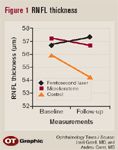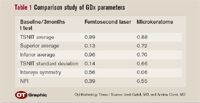Article
No damage to RNFL seen after using femtosecond laser to create lamellar flaps, study finds
Creating lamellar flaps with a certain femtosecond laser (IntraLase, Advanced Medical Optics) is as safe as those created with a mechanical microkeratome, according to the results of an international study.

Key Points

Critics had contended that creating flaps using the femtosecond laser may cause damage to the RNFL due to the increased suction time on the eye. We know that creation of a lamellar flap using both mechanical microkeratomes and femtosecond lasers leads to an elevation in IOP. The differences in vacuum time are significant when comparing these two methods of flap creation. In one study by Duffey, for example, the author noted a mean suction time of 10 to 15 seconds with a particular microkeratome (LSK-One, Moria) compared with around 60 seconds with the 15-kHz engine (IntraLase FS, Advanced Medical Optics).1 In our study, we measured how much more time the vacuum was on with both flap creation methods, what the IOP was while they were in use, and if they caused any RNFL damage postoperatively.
Outcomes

Other outcomes included the TSNIT index, mean superior thickness, mean inferior thickness, the standard deviation of the TSNIT index, intraocular symmetry, and the NFI. The latter is generated by neural network technology, trained with data from normal and glaucomatous eyes. Increasing values indicate increasing likelihood of glaucoma or fiber damage for the examined eye: 0 to 30 low, 31 to 50 suspect, 51 to 100 high.
Methods
Forty-two eyes of 21 patients undergoing consecutive bilateral LASIK were included in the study; age ranged from 23 to 48 years. Mean preoperative pachymetry was 560.27 μm, with a maximum of 620 μm and a minimum of 504 μm. Mean keratometric readings were 44.41 ± 1.52 and 43.48 ± 1.5. Twenty flaps were created with a certain microkeratome (Hansatome with Zero Compression Head, Bausch & Lomb), and 22 flaps with a femtosecond laser (IntraLase, Advanced Medical Optics). A major advantage of the femtosecond laser system used is that it allows the surgeon to customize almost all aspects of the flap.
Newsletter
Don’t miss out—get Ophthalmology Times updates on the latest clinical advancements and expert interviews, straight to your inbox.




